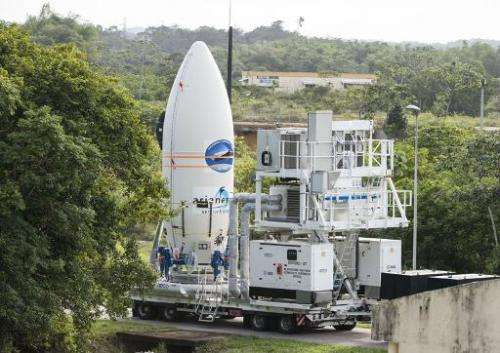Europe launches space plane with eye on strategic goal

Europe said it had launched a prototype space plane Wednesday in a strategy to join an elite club able to both launch a spacecraft and return it safely to Earth.
A Vega rocket lifted off from the European Space Agency's base in Kourou, French Guiana, bearing the novel Intermediate eXperimental Vehicle (IXV), ESA said in a webcast.
"Separation successful," launch control announced to applause after the payload separated from its rocket following an 18-minute ride.
The five-metre (16-feet), two-tonne wingless demonstrator is the first step in filling a gap in ESA's range of skills.
Europe can launch satellites, robot explorers and supply ships but unlike rival spacefarers—the United States, Russia and China—does not have the means to bring them back to Earth intact.
Nor does it have its own capacity for human flight—European astronauts instead have been taken aloft and returned to Earth aboard the US space shuttle or Russia's Soyuz.
"The IXV marks the latest step by Europe in the development of atmospheric reentry technologies, a key to manned flights," Arianespace, which stages ESA launches, said.
The automated 100-minute sub-orbital flight will take the IXV to a height of just over 400 kilometres (250 miles) before it descends at hypersonic speed.
It will then deploy a parachute and splash down in the Pacific around 3,000 kilometres west of the Galapagos Islands, deploying flotation bags so that it can be picked up by a recovery ship.
The IXV is crammed with sensors to monitor its performance in the demanding task of re-entry, where it will have to cope with searing temperatures and follow a glide trajectory to the chosen splashdown site.
In terms of design, the IXV seeks to strike a balance between flat-bottomed capsules—the tried-and-trust return-to-Earth vehicle since the pioneering days of space—and the US shuttle, a winged but complex and expensive system, two of which were lost before the craft was retired.
The IXV looks like a wedge whose surfaces have been slightly rounded, providing lift but less resistance than wings to atmospheric molecules.
Manoeuvrability in space comes from four thrusters, while two hind steering flaps are intended to stabilise and angle the craft for its return path.
Ceramic panels will shield it from temperatures up to 1,700 degrees Celsius (3,092 degrees Fahrenheit).
The prototype cost 170 million euros (192 million dollars) plus 40 million euros in launch costs, according to French officials.
© 2015 AFP





















